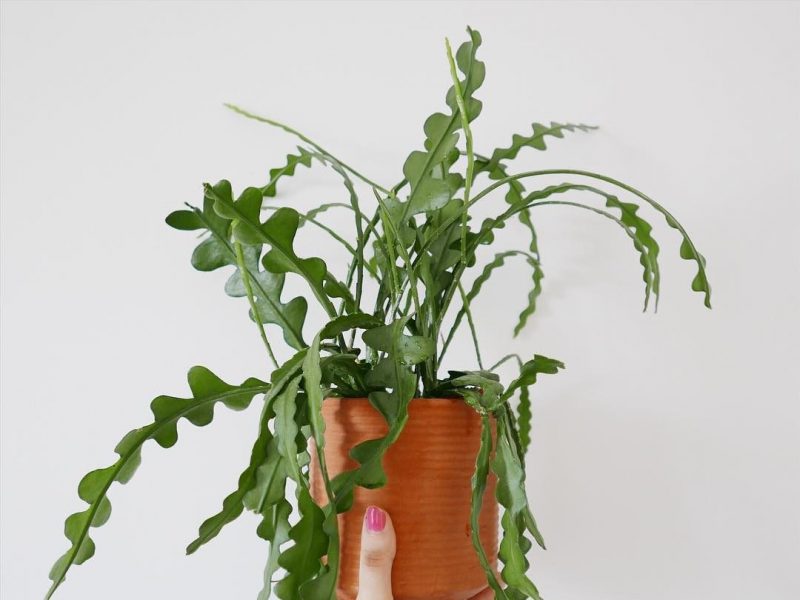
Adored for their flat zig-zag leaves, the Fishbone Cactus has seen a boost in popularity lately and we couldn’t be happier seeing them pop up in homes and plant shops across the world. Whilst they can be quite easy to care for and keep happy, some plant parents often find their Fishbone Cactus can turn quite wrinkly and shrivelled.
Causes of shrivelled wrinkly Fishbone Cactus leaves
In this post, we will delve into the different reasons that your Fishbone Cactus might be shrivelling up and dying. It’s important to take a close look at the leaves before going through the reasons as their softness is crucial to narrowing down the cause.
Too Much Sunlight
If the leaves on your Fishbone Cactus are very dry as well as shrivelled and wrinkly, then it may be sunburn causing the problem. Fishbone Cacti like bright but indirect sunlight and if sat in the windowsill during summer, this intense direct sunshine can actually scorch the leaves causing them to shrivel up.
Intense direct sunlight can also cause a hot spot which further dries out your Fishbone Cactus, leaving the leaves super crispy and winkled. If you think that direct sunlight is the cause of the shrivelled leaves on your Fishbone Cactus then move your plant somewhere a little shadier. You don’t want to move your plant anywhere super dark as they still need high levels of sunlight to thrive as they are a succulent so finding the right balance is key.
If you’re unsure how much light your plant gets compared to what it needs, a light meter can be a good way to track light throughout your home and see how it changes throughout the day and across the different seasons.
Not Enough Water
Another cause of dry, wrinkled or shrivelled Fishbone Cactus leaves is consistent underwatering. As they are a succulent plant, they don’t need that much water to thrive but they do need more than the average cactus or succulent plant. They will forgive the occasional time that you forget to water, but won’t be able to go months without a drop.
It’s important to ensure that your plant is in fact being underwatered before you change anything about your care routine. The worst thing would be to increase watering if not needed as overwatering will have serious consequences too. Take your plant out of the pot (whilst wearing gloves as those thin spikes can sometimes be very sharp) to inspect how the potting mix feels. If underwatered, the potting mix will fall apart and feel very sandy.
Once you have determined that your Fishbone Cactus is suffering from a lack of water, slowly reintroduce water to your plant rather than drowning it. A little bit once a day for a week should get your plant back on track.
Overwatering
If the shrivelled/wrinkled leaves on your Fishbone Cactus feel soft and mushy to touch then it may be overwatering that is causing the issue. When your plant is consistently overwatered it will mean the roots start to rot and can’t transport vital nutrients and oxygen to your plant which causes the leaves to die and shrivel up.
It’s quite easy to tell if your Fishbone Cactus is being overwatered as the potting mix will feel very soggy and clumpy and may have started to smell. Replace the potting mix immediately if it is waterlogged as leaving it to dry naturally just risks more damage to the plant. Trim away all dead leaves and roots so your Fishbone Cactus can focus its energy on growing new healthy growth.
Going forward cut back on either how often you water your Fishbone Cactus, or how much water you give it each time as this will help prevent your plant from sitting in waterlogged soil.
Cold Temperatures
Another cause of shrivelled wrinkly leaves (when partnered with soft leaves) is a drop in temperatures. Fishbone Cacti like warm environments and can really struggle in cold homes or if exposed to drafts. This is particularly a problem at night when temperatures drop and we are less likely to have the heating on.
If the leaves are wet whilst your plant is exposed to cool temperatures, there is a high risk of the soggy leaves rotting. When watering your Fishbone Cactus, make sure to water as close to the potting soil as possible to minimise the amount of water that splashes onto your leaves.
You can also avoid shrivelled leaves being caused by extreme temperatures by draft proofing all windows and doors and making sure your Fishbone Cactus isn’t close to an AC vent. Using a digital thermometer will really help you keep track of the temperature fluctuations and help avoid any further wrinkled leaves.
So those are the most common reasons why your Fishbone Cactus may be developing wrinkled or shrivelled leaves. We recommend keeping a close eye on the environment and your care routine over the next few weeks to ensure the issue is properly solved and the problem isn’t getting worse.
If you can’t seem to save your plant and reverse the issue, then propagate your Fishbone Cactus to save at least some of the healthy parts.
Check out our full Fishbone Cactus care guide for more information on other common problems, propagation and top tips to keep your plant happy and healthy.














